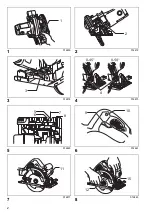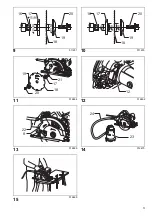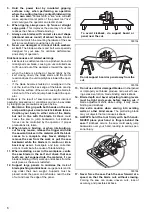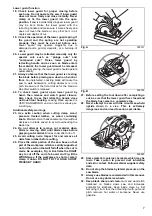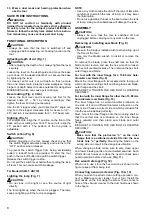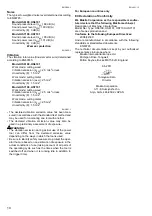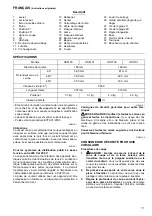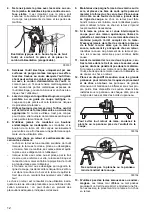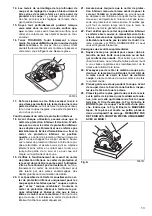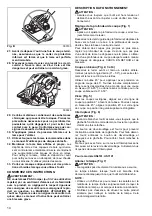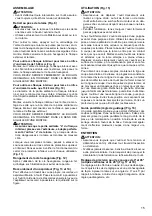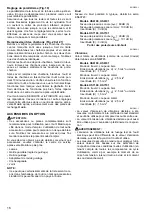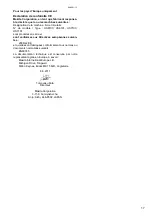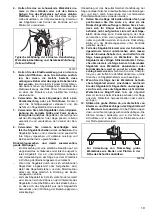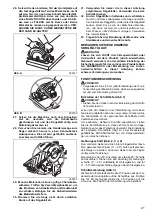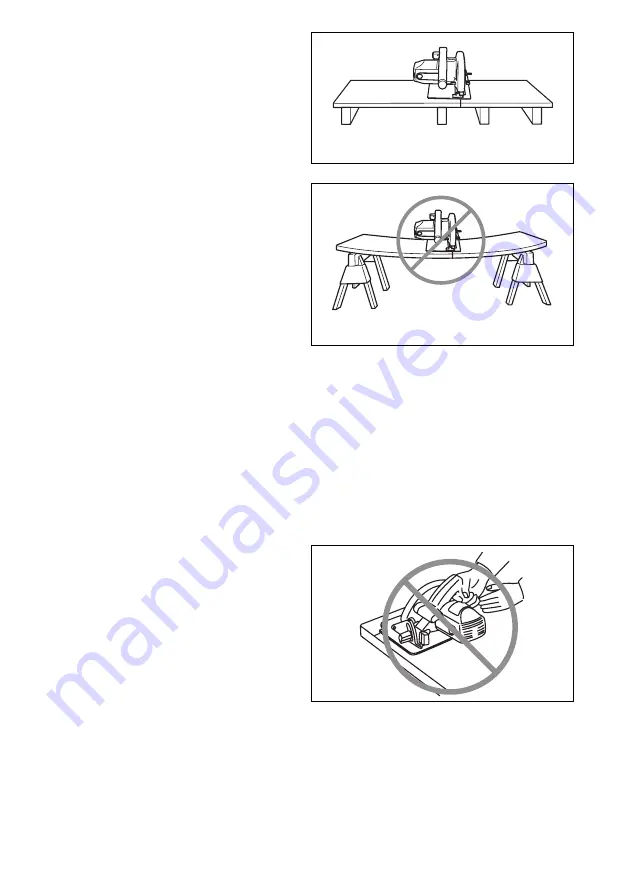
6
5.
Hold the power tool by insulated gripping
surfaces only, when performing an operation
where the cutting tool may contact hidden wiring
or its own cord.
Contact with a “live” wire will also
make exposed metal parts of the power tool “live”
and could give the operator an electric shock.
6.
When ripping, always use a rip fence or straight
edge guide.
This improves the accuracy of cut and
reduces the chance of blade binding.
7.
Always use blades with correct size and shape
(diamond versus round) of arbour holes.
Blades
that do not match the mounting hardware of the saw
will run eccentrically, causing loss of control.
8.
Never use damaged or incorrect blade washers
or bolt.
The blade washers and bolt were specially
designed for your saw, for optimum performance
and safety of operation.
Kickback causes and related warnings
–
kickback is a sudden reaction to a pinched, bound or
misaligned saw blade, causing an uncontrolled saw
to lift up and out of the workpiece toward the opera-
tor;
–
when the blade is pinched or bound tightly by the
kerf closing down, the blade stalls and the motor
reaction drives the unit rapidly back toward the oper-
ator;
–
if the blade becomes twisted or misaligned in the
cut, the teeth at the back edge of the blade can dig
into the top surface of the wood causing the blade to
climb out of the kerf and jump back toward the oper-
ator.
Kickback is the result of saw misuse and/or incorrect
operating procedures or conditions and can be avoided
by taking proper precautions as given below.
9.
Maintain a firm grip with both hands on the saw
and position your arms to resist kickback forces.
Position your body to either side of the blade,
but not in line with the blade.
Kickback could
cause the saw to jump backwards, but kickback
forces can be controlled by the operator, if proper
precautions are taken.
10. When blade is binding, or when interrupting a
cut for any reason, release the trigger and hold
the saw motionless in the material until the blade
comes to a complete stop. Never attempt to
remove the saw from the work or pull the saw
backward while the blade is in motion or kick-
back may occur.
Investigate and take corrective
actions to eliminate the cause of blade binding.
11. When restarting a saw in the workpiece, centre
the saw blade in the kerf and check that saw
teeth are not engaged into the material.
If saw
blade is binding, it may walk up or kickback from the
workpiece as the saw is restarted.
12. Support large panels to minimise the risk of
blade pinching and kickback.
Large panels tend to
sag under their own weight. Supports must be
placed under the panel on both sides, near the line
of cut and near the edge of the panel.
000154
000156
13. Do not use dull or damaged blades.
Unsharpened
or improperly set blades produce narrow kerf caus-
ing excessive friction, blade binding and kickback.
14. Blade depth and bevel adjusting locking levers
must be tight and secure before making cut.
If
blade adjustment shifts while cutting, it may cause
binding and kickback.
15. Use extra caution when sawing into existing
walls or other blind areas.
The protruding blade
may cut objects that can cause kickback.
16. ALWAYS hold the tool firmly with both hands.
NEVER place your hand or fingers behind the
saw.
If kickback occurs, the saw could easily jump
backwards over your hand, leading to serious per-
sonal injury.
000194
17. Never force the saw. Push the saw forward at a
speed so that the blade cuts without slowing.
Forcing the saw can cause uneven cuts, loss of
accuracy, and possible kickback.
To avoid kickback, do support board or
panel near the cut.
Do not support board or panel away from the
cut.
Summary of Contents for HS7100
Page 59: ...59 4 000157 5 6 7 8 9 10 11 12 T 000154 000156...
Page 60: ...60 13 o 14 15 16 000194 17 18 19 20 21 22 23 24 25 26 A B 000147 A...
Page 62: ...62 8 15 88 9 15 88 10 a a 11 12 13 14 Makita 15 16...
Page 71: ...71...
Page 72: ...Makita Corporation Anjo Aichi Japan www makita com 885084 994 IDE...
Page 73: ...McGrp Ru McGrp Ru...


